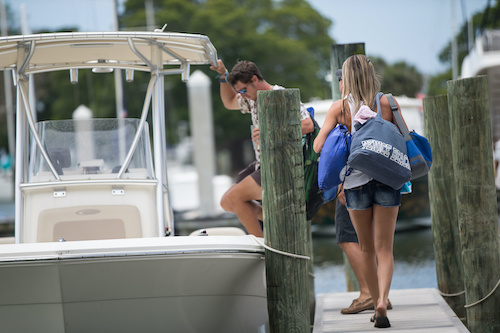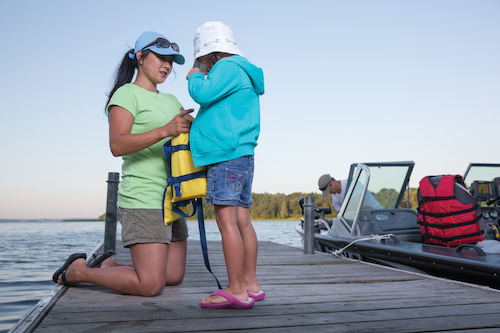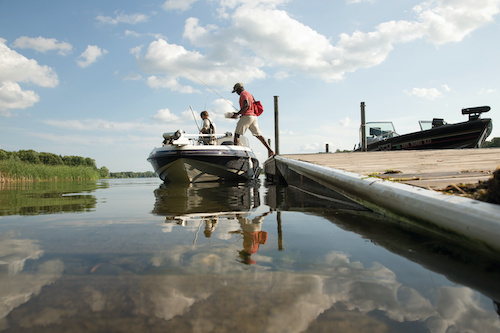What Supplies Do I Need for My New Boat?
Getting a new boat is an experience filled with excitement and fun. Oh, the places you’ll go! The daydreaming about itineraries and activities with friends and family tends to begin even before the boat’s engines are turned on.
But before you drop those throttles down and head out toward the horizon, it’s wise to take an inventory of what boat essentials you'll need on board.
1. Boat Safety Equipment
A good place to start when figuring out what you need is to take a look at our Boat Safety Checklist and Safety Equipment List, which includes many items that are required by the U.S. Coast Guard (and many that we already have on this list; i.e. registration numbers and documentation, PFDs, visual distress signals, fire extinguishers, sound producing devices, navigation lights and more).
Additional recommended equipment can include a VHF radio with a digital selective calling system.
Learn More in the Ultimate Safe Boating Guide
2. Registration Numbers and Proper Documentation
Check with your state and local authorities to make sure you have the correct paperwork, as well as the proper decals on your boat’s exterior.
Pro Tip: Having a waterproof pouch—something small that you can stow easily—to keep the paperwork safe and dry on board is always a smart idea. This pouch should be separate from, say, a bigger waterproof bag that’s used to protect cameras, smartphones and other accessories that guests bring aboard for the day.
Find about more documentation requirements in your state by reading How to Register a Boat.
3. Personal Floatation Devices (PFDs, also known as Life Jackets)
Next, think about life jackets. You need to consider not only how many people will be on board your boat at any given time, but also about what size those people are. If kids are part of the cruising plans, then children’s life jackets are a must. Some manufacturers also make “big and tall” life jackets for adults who tend to shop in sizes larger than XL.
Life Jackets, Vests & PFDs: How to Choose the Right Fit
4. Basic First Aid Kit
After the life jackets are stowed, think about adding a basic first aid kit to your onboard gear. Multiple manufacturers make these kits specifically for use on boats, with things like hydration tablets for people who get dehydrated, and survival blankets for people who endure extreme heat or cold (say, by falling overboard into cold water, or by overexerting themselves and staying in the water too long during water sports).
Learn more about what should be included in your first aid kit in Marine First Aid Kit Essentials.
5. Visual and Sound Signaling Devices
You’ll also need distress signaling devices in case of an emergency. Boats smaller than 16 feet only need a distress signal when operating between sunset and sunrise, so if you aren’t planning to boat at night, you’re probably good to go.
Boats 16 feet or bigger, however, need a combination of distress flag, floating smoke signals and/or flares. A boating-supply store can help you understand the options for your type of boat.
6. Fenders and Docking Equipment
Next, you'll want to buy some fenders. At some point, you’ll likely be pulling up alongside a dock or another boat to tie up, and having at least two fenders to provide a buffer zone will protect your boat as well as whatever you’re tying up to on any given day.
Depending on how you use your boat, you may want to get specialty fenders in addition to the basic ones that skippers typically use to port and starboard. A specialty fender can be shaped to protect a pontoon boat, a swim platform, a boat’s corner or other specific areas. Not to mention, an anchor and line will also come in handy.
Looking for a few tips to help you get the hang of docking your new boat?
Docking a Boat: Step-by-Step Guide
7. Boating Accessories
Last, of course, is the fun stuff—decking out your boat with all the latest gear and accessories, including (but not limited to):
- Big, fluffy towels for drying off after a dip;
- Water skis and tow toys for pulling behind the boat;
- And a cooler that holds all the ice, drinks and snacks you’ll need for a fun day out in the sun.
And speaking of sun: Always have an extra stash of sunscreen on board (check out Sunscreen & Sun Safety Tips for Boaters), for guests who forget to bring their own. You may even want to invest in a removable Bimini top or other type of portable shade, if you’re planning to be out on the water regularly at the height of the midday sun.
And should your boat’s ignition key not come with a floating keychain, then invest in one just in case your keys end up in the drink. Some floating key chains come with compartments inside, so you can use them to hold cash and other small items while heading ashore to a beach bar or waterfront restaurant.
Read Next: 10 First-Time Boating Tips for New Boaters
You May Also Like:


